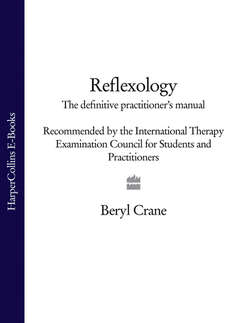Читать книгу Reflexology: The Definitive Practitioner's Manual: Recommended by the International Therapy Examination Council for Students and Practitoners - Beryl Crane - Страница 44
Reflexology and the body systems
ОглавлениеThe theory of reflexology is that a congestive state creates blockages of energy pathways; it has been conjectured that this blockage causes crystals to become deposited around the nerve endings, causing congestion right through the zone. The deposition around the nerve endings also causes a painful area when pressed or palpated. Over a period of treatment these areas become less sensitive as changes are induced within the circulatory and the nervous system by means of pressure stimuli. Such stimuli trigger the body’s inherent ability to move back to a state of correct balance and positive health and well-being. Working all areas of the hands, feet or ears and using a combination of reflexes will therefore eliminate most of these blocked energy pathways, energizing and revitalizing the recipient.
The natural homeostasis of living things can be disturbed by stress, which upsets the internal environment. Every part of the body is involved in maintaining this environment within the normal limits. It is only in cases of extreme or severe stress that the body is unable to cope. Homeostatic functions are maintained by nervous and chemical connections, with the pituitary body and other endocrine glands all working in unison. Feedback systems detect even the slightest change, setting off an immediate response in the form of neural impulses which are sent to neutralize any stress this may cause and to counterbalance the organ in question. If the body systems are not functioning at peak efficiency then disorders may manifest.
In the brain, three areas, the medulla oblongata, the hypothalamus and the pons Varolii (figure 2.23), are very important for this process. The first contains vital centres that control the rate and depth of breathing ‘respiration’, the rate of the heart beat and blood vessels, and not so vital centres that control reflexes such as swallowing, sneezing, coughing and vomiting. It also forms the major pathway for nerve impulses entering and leaving the skull. The hypothalamus also contains vital centres controlling body temperature, thirst, hunger, eating, water balance and the libido, and is also closely connected to emotional activity and sleep. The pons Varolii contains many nerve tracts running between the cerebral cortex and the spinal cord; it is where the trigeminal nerve emerges and also the sensory fibres relaying information about pain, touch and temperature.
Figure 2.23 A section through the brain
We can therefore see that reflexology might assist the homeostatic function by removing obstruction at the level of the autonomic nervous system. Fitzgerald said all zones must be free from irritation and obstructions for best results. He spoke of all existing pathological conditions being relieved and some even cured by zone therapy. He stated, however, that his work was not a panacea to all ills, but he was glad to offer his knowledge of zone therapy to physicians, surgeons and patients/clients to aid medicine and surgery and for them to make use of it in the practice of their profession.
